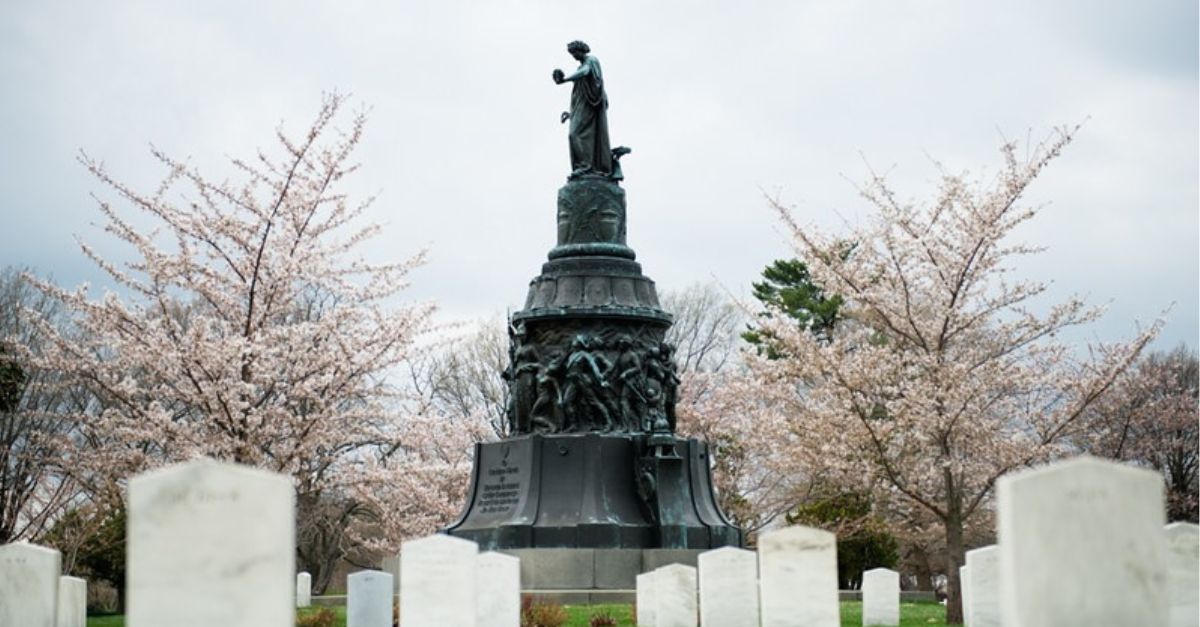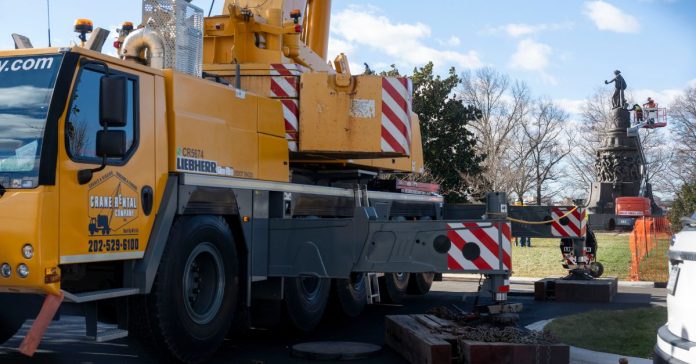
Workers prepare a Confederate Memorial for removal in Arlington National Cemetery on Monday, Dec. 18, 2023 in Arlington, Va. (AP Photo/Kevin Wolf)
A federal judge in Virginia approved the removal of a Confederate memorial inside Arlington National Cemetery after visiting the grounds himself and finding that allegations the Department of Defense had desecrated gravesites there as it dismantled the monument in question were totally unsupported.
“I saw no desecration of any graves. The grass wasn’t even disturbed,” U.S. District Judge Rossie Alston Jr. said Tuesday, according to The Associated Press.
The memorial was in the midst of being taken down under a 2022 federal order. Alston had initially sided with the plaintiffs, a group known as Defend Arlington, when they sought a restraining order to stop the work. Defend Arlington, in conjunction with the group Save Southern Heritage Florida, sued the Department of Defense on Dec. 17 alleging the memorial’s removal actively skirted environmental regulations and other guidelines in an unnecessary rush.
In his temporary restraining order, Alston had at first highlighted the plaintiffs’ concerns over potential damage or disturbances to graves and gravesites, even though the Defense Department said those concerns were mooted in various ways. Workers had, for instance, used an “existing pathway to move equipment and avoid interfering with grave sites or grave markers in the primary burial area,” the DOD said, according to court records reviewed by Law&Crime.
As for the memorial in question, entitled “New South,” Smithsonian Magazine noted in 2017 that proponents of its removal say it represents the “Lost Cause” ideology, or the belief in the “faithful slave” who relished his enslavement. This Confederate memorial, like others, is funded by the United Daughters of the Confederacy. It was first designed, as opponents to its removal emphasize, by Moses Ezekiel, a Confederate veteran and Jewish man. Ezekiel was also the first Jewish cadet at the Virginia Military Institute.

The Confederate Memorial “New South” at the Arlington National Cemetery will be removed, per a court order, by Dec. 22, 2023. Photo courtesy of Arlington National Cemetery.
It is surrounded at its base with more than a dozen Confederate soldier statues who appear, in some instances, next to fantastical godlike figures as well as life-size depictions of enslaved people. The Arlington Cemetery describes the memorial as featuring “highly sanitized depictions of slavery” with the romantic features of a 32-foot tall bronze female figure wearing a crown of olive leaves upon her head and sculpted hands clutching a laurel, plow stock and pruning hook.
The slaves depicted around the memorial include one labeled as “Mammy” and appears “holding the infant child of a white officer an enslaved man following his owner to war.”
The cemetery notes its history of the memorial online:
An inscription of the Latin phrase “Victrix causa diis placuit sed victa Caton” (“The victorious cause was pleasing to the gods, but the lost cause to Cato”) construes the South’s secession as a noble “Lost Cause.”
This narrative of the Lost Cause, which romanticized the pre-Civil War South and denied the horrors of slavery, fueled white backlash against Reconstruction and the rights that the 13th, 14th and 15th Amendments (1865-1870) had granted to African Americans.
In his own 18-page opinion, Alston reflected on this.
“This case essentially attempts to place this Court at the center of a great debate between individuals extolling the virtues, romanticism and history of the Old South and equally passionate individuals, with government endorsement, who believe that art accentuating what they believe is a harsh depiction of a time when a certain race of people were enslaved and treated like property is not deserving of a memorial at a place of refuge, honor and national recognition,” the judge wrote. “To be sure, this Court’s disposition does not have to resolve this great debate but rather is decided on the relevant case law, statutory law and administrative direction which governs this Court’s decision.”
When Defend Arlington sought the temporary restraining order, the group argued to Alston that grave markers were removed. Moses Ezekiel’s gravesite, near the monument he designed, was being damaged, for example, the group alleged.
But the government said that the markers’ removal was not “due to damage but to protect the markers because of the need for equipment to move around the Memorial” and that even a crane used for removal “will not enter the area near the Memorial at all,” court records show.
Headstone removal is typical when work is being done so there is no risk of incidental surface damage, and any headstone that is removed is also replaced.
“This is the standard and routine process for protection of graves when heavy equipment is required,” lawyers for the Defense Department wrote, attaching a copy of a final report from the federal Naming Commission that was earlier provided to Congress. The commission was set up in 2021 to rid the U.S. military of any monuments to the Confederacy.
At a hearing at the federal courthouse in Alexandria, Virginia, on Tuesday, AP reported that Alston was highly dubious over claims by the plaintiffs that the statue represented some sort of reconciliation.
One of the statues around the base of the bronze figure shows a “slave running after his ‘massa’ as he walks down the road,” Alston said.
“What is reconciling about that?” the judge, who is Black, said.
Alston was appointed to the bench in 2019 by former president Donald Trump.
The federally mandated date for removal is Jan. 1, 2024, but the government has said it will have the memorial removed by Dec. 22, and then it will be stored in a secure facility.
Have a tip we should know? [email protected]

